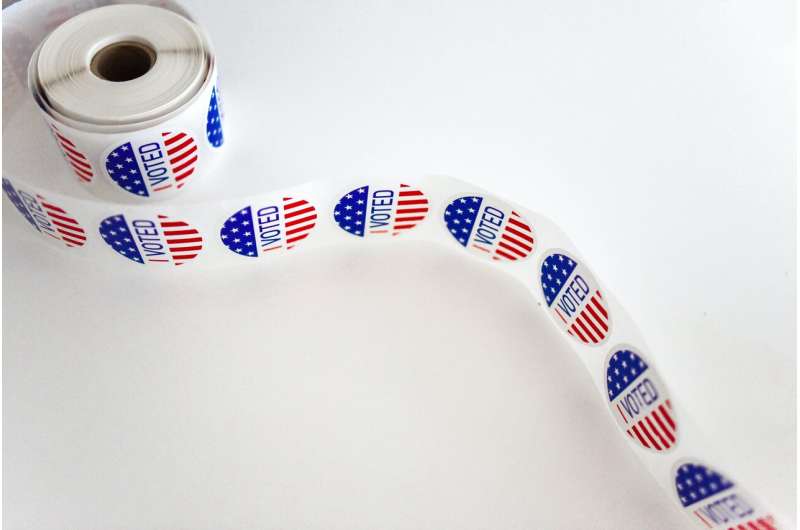Barriers to voting in elections linked to increased odds of being uninsured

Groups commonly targeted by voting restriction laws—those with low incomes, who are racial minorities, and who are young—are also less likely to be insured in states with more voting restrictions, according to a study by researchers at Columbia University Mailman School of Public Health and University of Alberta School of Public Health, Edmonton, Canada. However, those who are wealthier, white or older are no more likely to be uninsured, irrespective of the level of voting restrictions.
This is one of the first studies to show the relationship between barriers to voting in elections and access to health insurance in the United States. The findings are published in The Lancet Regional Health—Americas.
Implications of these findings underscore how access, or the lack of access, to power is associated with disparities in access to health care. The findings also provide evidence of the need for laws that assist rather than hinder minority and underserved groups in voting.
“An often overlooked social determinant of health is access to power. When access to power is disproportionately distributed, health inequities develop. The right to vote is one of the most basic forms of access to power. By voting, citizens elect representatives who advocate for their interests,” noted Roman Pabayo, Ph.D., University of Alberta School of Public Health, and first author.
The researchers used data collected from 242,727 adults in the 50 states and District of Columbia participating in the U.S. 2017 Behavioral Risk Factor Surveillance System (BRFSS). To quantify voting accessibility, the Cost of Voting Index (COVI), a global measure of barriers to voting within a state during a US election was used. The researchers adjusted for racial/ethnic identity, household income, and age group.
Many U.S. states have introduced barriers or restrictions on voting. Examples of voting restrictions include photo ID laws, no early voting, and same day registration not being allowed for elections. These laws are similar to “Jim Crow” laws which incorporated voting restrictions such as voter suppression and may reduce representation in legislative bodies. These same disadvantaged groups are thus less likely to have representatives to advocate for their interests and lifesaving goods, such as health insurance.
The association of greater voter restrictions and an overall increased odds of being uninsured was observed among non-Hispanic Black, Hispanic, Asian, and other non-Hispanic U.S. adults, but not among white non-Hispanic and Native U.S. adults. Likewise, an increase in voting restrictions was observed among adults from low-income households, but not among those with incomes greater than $75,000. This association was observed among young adults but not among those aged 45 to 64.
Thus, in order to decrease health inequities, such as the disparities in health care access, voting restrictions that disproportionately affect racial and demographic groups should be removed, according to the researchers.
“At the core of any democracy is the notion that we elect leaders to serve our best interests. When some groups are excluded from the democratic process, their voices are not heard, and the consequences can be deadly,” said Peter Muennig, MD, professor of health policy and management at Columbia Mailman School, and senior author. “The next step in this process is to explore other, broader consequences of voter restriction laws. Are they associated with shootings? Incarcerations for possession of substances that are legal in other states? Overall mortality?”
“When restrictions are more likely to prevent racial minorities, younger adults, and those from low socioeconomic backgrounds, from voting, legislation and policies that benefit their health are less likely to be enacted. Thus, ensuring the right to vote for all citizens may be one way to reduce population health inequities,” said Pabayo.
Co-authors are Sze Yan Liu, Montclair State University; Erin Grinshteyn, University of San Francisco; and Daniel Cook, University of Nevada.
Ranking the relative restrictiveness of each state’s voting environment in 2020
Roman Pabayo et al, Barriers to Voting and Access to Health Insurance Among US Adults: A Cross-Sectional Study, The Lancet Regional Health—Americas (2021). DOI: 10.1016/j.lana.2021.100026
Citation:
Barriers to voting in elections linked to increased odds of being uninsured (2021, August 4)
retrieved 4 August 2021
from https://phys.org/news/2021-08-barriers-voting-elections-linked-odds.html
This document is subject to copyright. Apart from any fair dealing for the purpose of private study or research, no
part may be reproduced without the written permission. The content is provided for information purposes only.
For all the latest Science News Click Here
For the latest news and updates, follow us on Google News.

